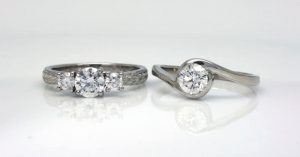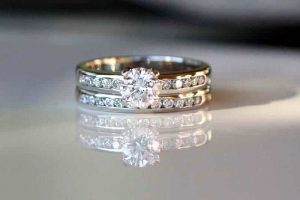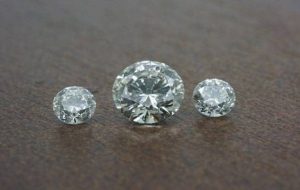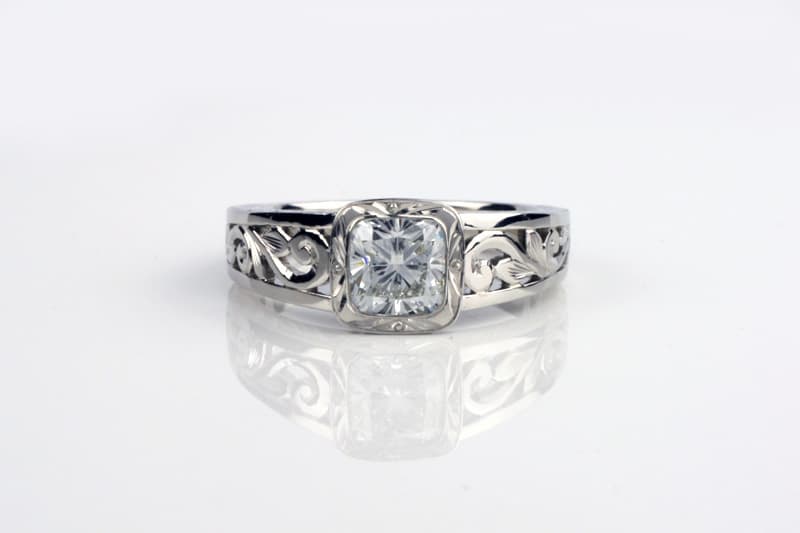If you are in the market for a diamond engagement ring (or other diamond jewellery), the option of buying lab-created diamonds may be on your radar.
Before about 2017 they barely rated a mention, but now in the early 2020s they’re commonplace in the mainstream diamond jewellery market.
Initially lab-diamonds gained a lot of attention because of their claimed ethical credentials and because they were notably less expensive than their mined counterparts.
As with anything that is well served by marketing hype, not all claims can be supported by fact. There are pros and cons with all diamonds, regardless of origin. This post answers five frequent questions about lab-created diamonds (plus there’s a bonus question and answer you might not have thought about).
1. Are lab diamonds “real” diamonds?
Short answer: Yes.
From a technical perspective, diamonds grown in a lab are (mostly) optically and physically identical to diamonds that come out of the ground. The only differences are in the chemical make-up of some of the microscopic imperfections or inclusions in both.
They have the same specific gravity (3.52), the same refractive index (2.42), the same hardness (10 on Mohs Scale) and the same chemical composition.

The ring on the left features lab-grown diamonds. The one on the right, an Argyle mine-origin diamond. Consumers can’t tell the difference just by looking at them, so how do you set them apart?
And this is not my opinion, nor the opinion of the lab-created diamond industry. Not only is this how they were defined in my Gemmology studies, this was a ruling made by the US Federal Trade Commission (FTC) in June of 2018. The FTC is an independent body with the charter of protecting consumers’ interests.
In that same ruling, the FTC removed the word ‘natural’ when defining diamonds. Since then, they have removed the word ‘synthetic’ to describe lab-created diamonds. The mined diamond industry doesn’t like it and has been vocal about it ever since. The lab diamond industry did a little happy dance.
So, on the ‘real’ question- the answer is yes. Science (and the FTC) says lab-created diamonds are the real thing.
2. How is a diamond grown in a factory?
In a word – science.
The long version is somewhat more complicated.
Here is the in-between version (apologies to actual scientists reading this):
There are two main growth methods. CVD (chemical vapor deposition) and HPHT (high pressure/high temperature).
CVD diamonds are grown at a lower temperature (around 800 degrees – so not exactly frosty) in an industrial-strength microwave. They form from the chemical interaction of hydrogen and methane. The diamonds grow atom by atom – deposited layer upon layer as they gradually form plate-like diamond crystals.
HPHT diamond growth starts with graphite over a diamond seed. It is placed in a pressure chamber where it is kept under immense continuous pressure and heat. The graphite becomes liquid and then crystallises.
Growth takes anything from three to ten weeks depending on the method and the desired size of the finished crystals.
Like many other industrial processes, both methods are energy hungry.
3. Do lab-created diamonds have a lower carbon footprint than mined diamonds?
One of the reasons lab-created diamonds quickly gained so much traction in the diamond jewellery space was because producers claimed to offer a much more environmentally friendly product than their mine-origin counterparts.
Diamond Foundry, one of the big names in the lab-diamond jewellery world, heavily promoted the (verified) carbon neutrality of their diamonds and jewellery. This (likely unintentionally), opened the door for other lab-diamond producers to make the same sorts of claims. Unfortunately, these claims are frequently made without any factual basis.
Now it seems the general public, helped by the media, believe that if it’s lab-created it must be ‘eco-friendly’.
This is only true some of the time.
The reality is – like their mine-origin counterparts – some producers have a bigger carbon footprint than others. It all depends on the location of production and the source of the energy used to either create the diamond or dig it up.
The important thing is to find out where the diamond was made or mined. At its most basic level, a lab-created diamond grown with electricity generated using fossil fuels will have a much larger carbon footprint than one grown using electricity from renewable sources. The challenge in the lab-created space is many producers will not disclose this.
Likewise, with mined diamonds, it’s important to get all the facts before declaring they are all bad or all good – from a carbon cost perspective.
A good example is the (now closed) Argyle mine in Western Australia. Due to access to renewable energy, the efficiency of mining and the high yield, Argyle diamonds have a much lower carbon footprint than those from South African mines (where 95% of the electricity supply comes from coal-fired power stations).
This results in Argyle diamonds having a carbon cost of less than 1kg* of CO2e per carat compared with 57kgs per carat for the mining industry average (Better Diamond Initiative, 2014).
In other words, just because it’s lab-created, don’t assume it has a low carbon cost. Likewise, just because a diamond comes from a mine, that doesn’t mean it’s automatically ‘worse’.
Whether it’s lab-created or mine-origin, be concerned about the performance of the specific producer. If that information isn’t available, then find out what you can about the ethics of the retailer you are working with.
*According to Argyle Diamonds Sustainability Report, 2017, the mine produced almost 60 million carats of industrial and jewellery grade diamonds that year with a net carbon cost of just over 6 tonnes of greenhouse gas emissions. This equates to 0.1kgs/carat.
4. Are lab diamonds ethical?

Engagement and wedding ring set with Argyle diamonds.
The question of whether lab diamonds are ethical or not is one that divides the jewellery industry. The thing is, whether you vote yes or no depends very much on your values. It also depends who the producer is and the inputs from the rest of their supply chain – much more than which part of the industry they’re from.
We’ve already covered the topic of carbon footprint, but that’s only one aspect of the ethics debate. If your number one concern is climate change, then of course it’s a very important issue. But there are other things think about too.
Human Rights
Lab-created diamonds are mostly produced in factory environments in industrialised regions. As a result, it’s reasonable to assume the rights of those factory workers and technicians are no more or less at risk than their colleagues in other similar professions. That said, a lab-diamond factory worker in the UK possibly has a better deal than one working in some parts of India, China or Russia.
This same thinking applies to medium and large-scale diamond mining. But that mining can also impact the rights of other people living in the region. Whilst the employees of the diamond mine operation might be okay, that does not mean the local villagers aren’t having their rights violated.
Things get even more complicated when you look at small-scale (or artisanal) diamond mining, especially in developing countries where the rule of law is often non-existent. (Think ‘blood diamonds’, child labour and toxic outputs.)
So, being able to track the point of origin of diamonds is vitally important.
And then there are the diamond cutting factories.
Lab-created and mine-origin diamonds both need to be cut and polished. 90% of the world’s supply of both are cut in India. Some cutting factories take good care of their employees. Others, not so much.
Exploitation, child labour and unsafe working conditions are very real concerns in the diamond cutting industry. There needs to be transparency in the supply chain.
Environmental Impact
Though it’s true most medium and large-scale mining operations are currently doing a much better job of taking care of the local environment, there are still harms. It’s hard to argue that a diamond mine in a sensitive environment, say, inside the Arctic Circle in northern Canada, is not doing meaningful harm to local ecosystems.
Even if the mine itself has a small footprint, you still have all the ancillary impacts from human habitation. This includes displacement of wildlife, the impact of building roads, water runoff, dust, light and noise pollution and more.
Lab-created diamond factories usually operate in already urbanized areas. So, whilst they may not be making things better, their impacts are much less dramatic than those delivered by mining operations in pristine wilderness areas.
When making your choice, the points for you to consider are:
- How do YOU define ‘ethical’ when it comes to raw materials? Do you put the environment above everything else, or do you consider local economic benefits too?
- Who do you want to benefit from your purchase? and
- What other ethical initiatives does the company you are buying from support?
The lab diamond industry does not always offer us straightforward answers. However, when making any significant purchase, you can always ask yourself:
- Have you done the most you can to align with your values in this purchase?
- If this is an engagement ring or a gift for someone else, will it align with their values?
- Do you trust your supplier? and
- Will a person who might inherit this piece in the future feel proud to own it?
5. How much are lab-created diamonds?
Like all diamonds, price depends on many variables. These are mainly centred around the four Cs – carat, colour, clarity and cut.
For lab diamonds, it is best to stick in the D to G colour range with clarity of Si or better. Ensure they have an Ideal or Excellent cut grade with a minimum of ‘very good’ for polish and symmetry.
This still leaves a lot of room for significant price differences. In the one carat sizes, different colour and clarity grades can vary by more than $2,000.
It is important to ask yourself what matters most to you when choosing a diamond for a special ring. Do you want the biggest you can afford or is the quality and beauty of the main diamond more important?
Either way, it’s a good idea to be flexible in your requirements. That way you may surprise yourself with a diamond that exceeded expectations at a price that doesn’t blow the budget.

CVD (carbon vapour deposition) lab grown diamonds.
As a rough guide (as of early 2022), for lab-diamonds expect to pay:
- $900 – $1,100 for a half carat diamond;
- $1,600 – $2,000 for 75 points;
- $2,900 – $5,000 for 1 carat;
- $5,400 – $8,900 for 1.5 carats; or
- $9,300 – $12,500 for 2 carats.
Price does vary with the exchange rate and diamonds are subject to availability. But as new diamonds are being grown all the time, you will most likely find exactly what you are looking for if you’re prepared to be a little patient.
BONUS QUESTION
6. Do lab-created diamonds have any resale value?
If you do any in-depth research into lab-created diamonds, you’ll come across the argument from mine-origin suppliers that mine-origin diamonds “retain their value” whereas lab-created diamonds (probably) won’t.
Their argument is supported by the fact that there is an established market for second-hand diamonds (albeit not a formal one) whereas no such market exists for lab-created diamonds – yet.
Also, the mine-origin people point out that diamonds that come out of the ground are a finite resource – once they’re gone, they’re gone. Whereas lab-created diamonds could, theoretically, be produced indefinitely in infinite numbers.
From our perspective, unless you’re in the investment market, we find that few of our customers worry about resale value. Australians tend not to buy an engagement ring to sell or trade it in a few years later. It is also more likely that an inherited diamond will be worn by the next generation either as is or in a remade piece.
But if you worry about future resale value, here are some points to consider:
1) The resale value of an engagement ring isn’t just about the diamonds or gemstones. The value is also tied up in the precious metal and the brand, designer or maker. A ring from a prestige brand will always resell better than one from “Rings ‘R Us”;
2) The claim “natural diamonds retain their value” is very open to interpretation. The reality is, the resale value of a diamond is tied to the current wholesale price of equivalent ‘new’ diamonds.
It also depends on the diamond. Unless the diamond has a special pedigree, you would be unlikely to get more than the going wholesale price. No diamond dealer is going to pay more than that. On the open market, depending on how much mark-up was on the diamond to start with, you may only get 40% or less of the original purchase price. When set in a ring, you may get as little as 10-35% of the original retail price. The second-hand jewellery world is very much a buyers’ market.
3) There are significant savings to be had by buying lab-created diamonds. So, the question is, what else could you do with the money you save now? It’s true that you might not get much back if you were to try and sell a lab-created diamond sometime in the future, but that could also happen with a mine-origin diamond. Meanwhile, you’ve had the use of the money you saved. And of course, if you can’t imagine ever wanting to resell your engagement ring, resale value is unimportant.
4) No one knows whether lab-created diamonds will have a meaningful resale value in the future. On the other hand, perhaps branded lab-created diamonds with a known low carbon footprint will value higher than no-name, mine-origin diamonds. Only time will tell.
To summarize:
- Yes, lab diamonds are real diamonds.
- They are grown by the CVD (chemical vapor deposition) or HPHT (high pressure/high temperature) methods.
- They can have a lower carbon footprint than mined diamonds but it depends on the producer.
- They can be more ethical in some respects than their mined counterparts (due diligence required).
- Prices start at $1200 for half-carat lab diamonds.
- They are less expensive than their mined counterparts, and
- It is not yet known whether they have a good resale value.
In the end, it comes down to budget and personal values and preferences.
While not an exhaustive question and answer list, it should be a good start. I hope that it has helped you to have a better understanding of the current state of the lab diamond market.
If you have any other questions about lab-created or other diamonds – or if you would like us to source a diamond for you, you’re welcome to send us a message.
About EJA
Established in 2007, Ethical Jewellery Australia is an online engagement, wedding ring and bespoke jewellery specialist. Every piece we create is made to order. With the exception of our ‘classics’ range, all engagement and wedding rings are custom designed.
We take our customers through the whole process from design to sourcing and finally to manufacturing.
All rings are handmade in Australia with recycled metals. (We can also supply Fair Trade gold if requested.)
Likewise, we only every use ethically sourced diamonds and gemstones. You can choose from Argyle, recycled, vintage and lab-grown diamonds, Australian, US, Fair Trade, recycled and lab-grown coloured gemstones.
By the way, we offer an Australia-wide service.
About the Author: Melinda Bailey

Melinda Bailey, FGAA Founder and Principal Jewellery Designer
Melinda, a jewellery designer and registered Gemmologist, is the driving force behind Ethical Jewellery Australia (EJA) and creator of ‘The Promised Ring’.
Melinda works directly with customers to guide them through the process of designing their jewellery and works with our suppliers to source the material for each piece. She is the link between the customer and our jewellers and oversees manufacturing and quality control.
Melinda is a Fellow of the GAA (Gemmological Association of Australia).


Recent Comments